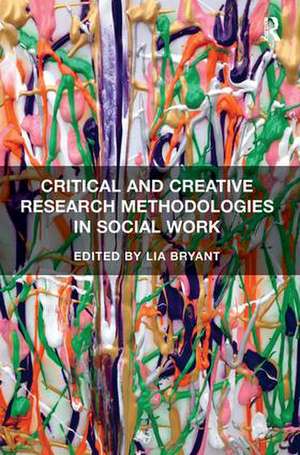Critical and Creative Research Methodologies in Social Work
Autor Lia Bryanten Limba Engleză Paperback – 22 ian 2018
| Toate formatele și edițiile | Preț | Express |
|---|---|---|
| Paperback (1) | 422.59 lei 6-8 săpt. | |
| Taylor & Francis – 22 ian 2018 | 422.59 lei 6-8 săpt. | |
| Hardback (1) | 1002.99 lei 6-8 săpt. | |
| Taylor & Francis – 28 iul 2015 | 1002.99 lei 6-8 săpt. |
Preț: 422.59 lei
Nou
Puncte Express: 634
Preț estimativ în valută:
80.86€ • 84.65$ • 66.91£
80.86€ • 84.65$ • 66.91£
Carte tipărită la comandă
Livrare economică 07-21 aprilie
Preluare comenzi: 021 569.72.76
Specificații
ISBN-13: 9781138494350
ISBN-10: 1138494356
Pagini: 250
Dimensiuni: 156 x 234 x 13 mm
Greutate: 0.45 kg
Ediția:1
Editura: Taylor & Francis
Colecția Routledge
Locul publicării:Oxford, United Kingdom
ISBN-10: 1138494356
Pagini: 250
Dimensiuni: 156 x 234 x 13 mm
Greutate: 0.45 kg
Ediția:1
Editura: Taylor & Francis
Colecția Routledge
Locul publicării:Oxford, United Kingdom
Notă biografică
Lia Bryant is an Associate Professor in the School of Psychology, Social Work and Social Policy at the University of South Australia. She supervises several doctoral students, teaches undergraduate research courses including applied research for honours students and a post-graduate subject focused on innovation in research. She is a sociologist and social worker who has published widely on gender, sexuality and embodiment in the rural, with an ongoing interest in research methodologies. Dr Bryant has authored Gender and Rurality with Barbara Pini, and the edited international collection on Sexuality, Rurality and Geography with Andrew Gorman-Murray and Barbara Pini. She has also published in numerous journals including Journal of Rural Studies, International Journal of Qualitative Research, Sociologia Ruralis, Australian Feminist Studies and Human Relations.
Recenzii
’I love this book. It is just what I and my PhD students have been waiting for. Engaging and scholarly, this book challenges social workers to move beyond conventional models of research to explore critical and creative research methodologies to promote social justice. The practicalities of writing ethnography, the importance of situating oneself and the value of reflexivity are all emphasized, alongside innovative ways of using arts-based methods, including photography, stories, film, sculpture and drawing, to empower research participants. It is a wonderful anthology.’ Bob Pease, Deakin University, Australia ’Interest in the development of creative practices in research has grown apace in recent years. This stunning book engages with a range of innovative techniques grounding them in the strong methodological orientation of social work’s social justice principles. A scholarly collection that significantly advances the field of social work research and is a must buy.’ Charlotte Williams, RMIT University, Australia ’This unique book presents new approaches to social work research which in their creativity challenge the very way in which we think of research methodology. The authors share their experiences in their multifaceted studies in and about social work. The insights of this book go far beyond individual topics as the creative and critical methods challenge the present rationales of academia. The well-argued and wise views of this book should not be ignored by anyone interested in knowledge in social work.’ Tarja Pösö, University of Tampere, Finland
Cuprins
Introduction, LiaBryant; Part 1 Narrative and Action; Chapter 1 Storytelling as a Research Method, FatinShabbar; Chapter 2 Investigating the Impact of Sexual Violence through Ethnographic Longitudinal Reflection, AndreaNikischer; Chapter 3 Communicative Methodology of Research and Romaní Migrant Women in Spain, AitorGómez, AriadnaMunté; Chapter 4 – Narratives of Reciprocity in ‘Yarning Up’ Part Icipatory Research, DeirdreTedmanson; Chapter 5 Reflexivity as Autoethnography in Indigenous Research, AmyParkes; Part 2 Creating Critical Exchanges in Social Work Using Visual and Textual Methods; Chapter 6 Opening the Lens to See, Feel and Hear, LiaBryant, MonaLivholts; Chapter 7 Imagine Transfigurement, MonaLivholts; Chapter 8 Digital Ethnography, DanielleMay; Chapter 9 Creative Endeavours in Eating Disorder Research, LisaHodge; Chapter 10 Touching on Emotions, FionaBuchanan; Chapter 11 Arts Based Methods in Social Work Education and Research as Critical Method, EphratHuss, DoritSegal-Engelchin, RoniKaufman; Chapter 101 Social Creativity and Social Change, LiaBryant;
Descriere
This volume develops critical and creative research methodologies that place questions of social justice at their centre and take innovative approaches to collecting, analysing, interpreting and presenting research data. The first section of the book examines textual data produced from an array of methodologies focused on the spoken and/or written word. These approaches allow those who are often silenced to speak by providing space and time to capture memory and meanings that may not come to light in a time driven structured research method like an interview or a questionnaire. The second section of the book discusses visual methods, including an examination of historical artefacts like, photographs and objects, and participant engagement with art, specifically clay sculpture and drawings.
